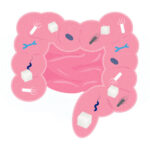The gut-brain connection: A new approach to OCD and tic disorders?

It’s natural for young children to use routines to help them navigate the world and for older children and teens to zero in on interests and hobbies. But if they veer into disruptive, unwanted obsessions or thoughts or the need to perform compulsive rituals, they may have obsessive-compulsive disorder (OCD).
We know that OCD is associated with disruptions in certain brain networks, but not what causes these disruptions. Only one-third of children have full improvement of their symptoms with current medications; the rest have only partial or no improvement or may struggle with medication side effects. Seeking new approaches, psychiatrists, neurologists, and neuroscientists at Boston Children’s Hospital are teaming up to better understand what causes OCD.
Their specific interest: The intestinal microbiome.
“The microbes in the gut must exist in balance. But sometimes that balance gets out of whack,” explains Tamar Katz, MD, PhD, an attending psychiatrist with Boston Children’s Department of Psychiatry and Behavioral Sciences. “There are lots of studies showing that the microbiome affects depression, anxiety, autism, Parkinson’s disease, and Huntington’s disease, as well as adult OCD.”
Could the microbiome play a role in OCD in children? And could altering the microbiome ease OCD symptoms?
Intestinal microbes either synthesize or metabolize a large percentage of neurotransmitters, such as serotonin, gamma-aminobutyric acid (GABA), and dopamine, Katz says. In mouse studies, altering the intestinal microbiome changes behavior and neurological development.
Diet, the microbiome, and OCD
As a starting point in children, Katz and Kinga Tomczak, MD, PhD, director of the Tic Disorders and Tourette Syndrome Program in the Department of Neurology, have begun a study to characterize the intestinal microbiome in children with OCD and healthy volunteers, as well as children with tic disorders. Many children with OCD also have tics, and the two disorders have much overlap in their mechanisms.
The researchers are analyzing stool samples from the three groups to look for differences, especially in microbial species that are involved in serotonin, dopamine, and glutamate metabolism. They then hope to correlate the microbiome with symptom severity.
It’s challenging work since the microbiome isn’t static — and neither are OCD or tic disorders, which can wax and wane. “The microbiome is a living, breathing ecosystem that fluctuates over time,” says Katz. “It is highly affected by exercise, sleep, and what we eat. How the fluctuations correlate with OCD is still to be determined. There’s a lot of information we still need.”
OCD and brain circuits
On a separate front, Katz and Tomczak are collaborating with Takao Hensch, PhD, of the F.M. Kirby Neurobiology Center, who is exploring OCD’s neurobiology in a mouse model. Based on clues from human functional MRI studies as to which brain circuits might be involved, he is probing these circuits to identify possible targets for treatment.
Currently, Hensch is focused on the corticostriatal circuit, which is involved in perseverative thoughts, a hallmark of OCD.
“We’ve established whole-brain imaging and analytical methods to show when brain activity gets stuck in more rigid patterns,” he says. “These can flip as the brain shifts to another train of thought, so behavior becomes less rigid and perseverative.”
The team’s goal is to test therapies or dietary interventions in the mouse model to see how they disrupt that perseverative pattern. Hensch’s groundbreaking work on critical periods — developmental windows when the brain’s wiring is more readily changed — may shed light on when best to time such interventions.
In mouse models of autism, Hensch has used genetic approaches to open a critical period or help the brain move out of a rigid, perseverative state. “I would like to see that with a clinical drug or microbiome intervention,” he says.
An alternative to medications?
Through all these studies, Katz and Tomczak hope to find interventions that might tip the microbiome into a healthier state and prevent or ease OCD and tic symptoms. These could include probiotics or diets with more fiber and fewer fatty foods, which tend to favor growth of “good” bacteria.
“If the microbiome indeed plays a role, and we could modify it through dietary and lifestyle changes rather than medications, it would be a great addition to our current treatment options,” says Tomczak.
Learn more about the clinical microbiome study and other research in the Department of Psychiatry and Behavioral Sciences and F.M Kirby Neurobiology Center at Boston Children’s.
Related Posts :
-

Treating brain 'hotspots' and networks to address autism, aggression, and more
What if doctors could break down conditions like autism into their key symptoms, map these symptoms to “hotspots” in the ...
-

Shaping our intestinal microbiome: What makes certain microbes more ‘fit’?
We now know the microbes that live in our intestines — often called our microbiome — influence our health in many ways. ...
-

Could ADHD be diagnosed genetically?
Despite it being very common, ADHD is often missed until a child reaches age 7 or older. By that time, they ...
-

Piecing together the preterm infant microbiome
The human microbiome — the collection of microbes living in the gut — is now recognized as an important contributor to health ...





